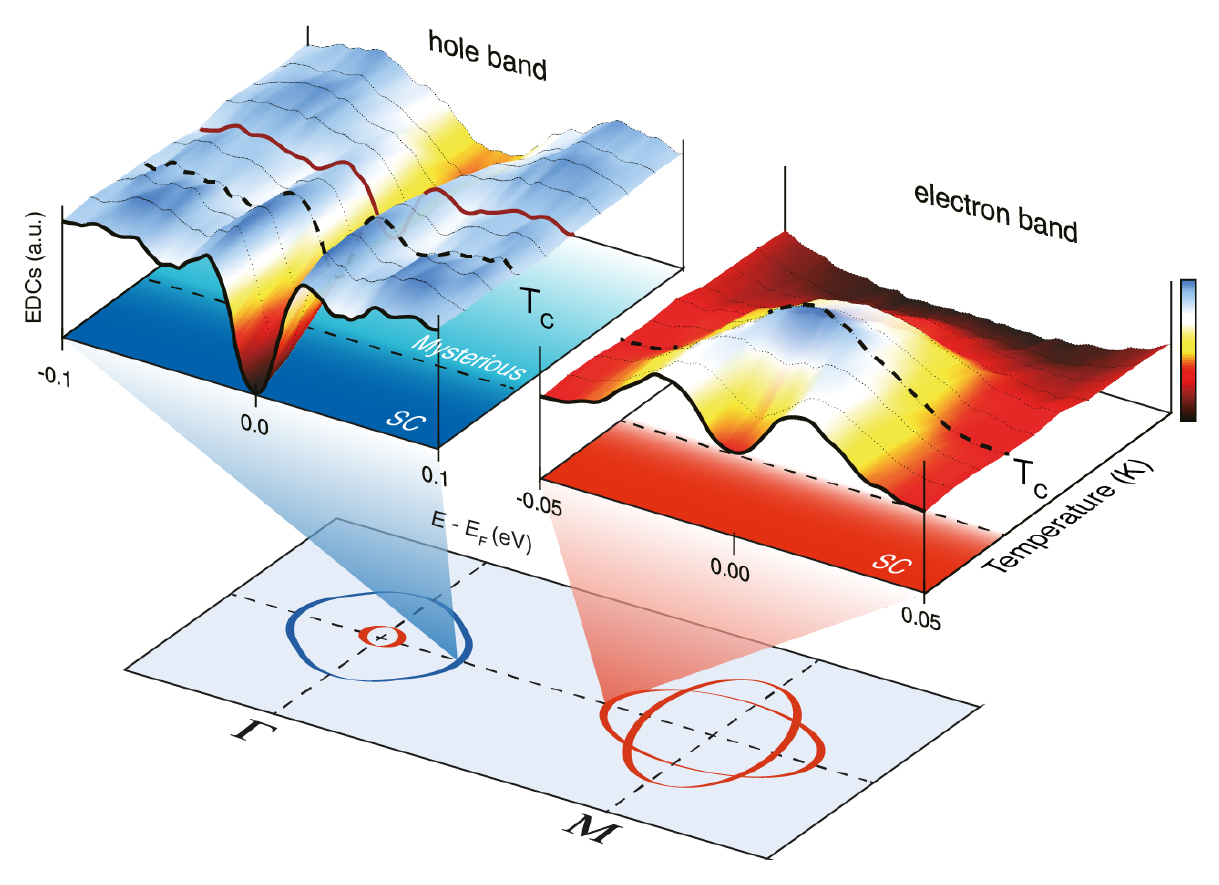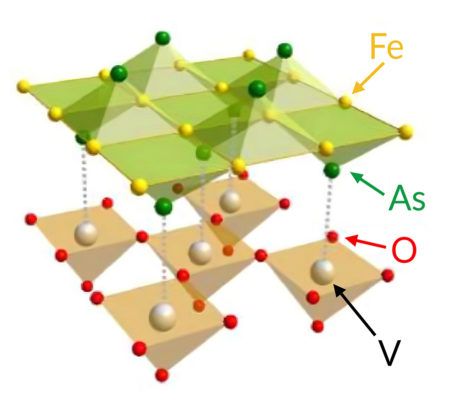SCIENTIFIC ACHIEVEMENT
Using the Advanced Light Source (ALS), researchers found that a mysterious phase transition in an iron-based superconductor is driven by interactions between the material’s 2D layers.
SIGNIFICANCE AND IMPACT
The results counter the assumption that interlayer coupling is negligible in such materials, suggesting instead that the interactions can be an effective way to tune superconductivity.

Heterostructured superconducting systems

The interleaving of distinct two-dimensional layers—the building blocks of what are known as heterostructures—can lead to the emergence of unexpected, rich physics not observed in the constituent materials alone. Based on this, researchers have been busily shuffling the deck in search of layer combinations that will yield exotic physical properties. In particular, a heterostructure consisting of strongly correlated electron systems might produce novel effects, including drastically boosted superconductivity.
The iron-based superconductor, Sr2VO3FeAs, is a heterostructure of iron arsenide (SrFeAs) and a transition-metal oxide (SrVO3). The superconducting transition temperature (TC) is about 30 K, but an unusual phase transition occurs at about 150 K that cannot easily be explained within conventional theoretical frameworks. Here, using band structures revealed through angle-resolved photoemission spectroscopy (ARPES), researchers concluded that the mysterious phase originates from surprisingly strong proximity-induced interactions between neighboring layers.
Broken symmetry in correlated systems
Strongly correlated electron systems (i.e., where strong interactions between electrons must be accounted for and not averaged out) often exhibit a variety of self-organized forms of broken symmetry—localized variations in spin direction, charge distribution, or bond angle, for example. In correlated itinerant-electron systems, exemplified by doped copper- and iron-based superconductors, multiple many-body instabilities promote a rich and complex landscape of electronic orders. The resulting broken symmetries register their footprints in the electronic structure through features such as band folding, band splitting, and band-gap opening. Investigating these footprints in turn helps characterize the different phases—what type of phase transition occurs, what kind of interaction is involved, and how the system lowers its energy across the phase transition.
At 150 K, an intriguing phase transition in Sr2VO3FeAs has been clearly indicated by anomalies in temperature-dependent measurements of resistivity and specific heat. Despite its clear thermodynamic signature, the phase transition cannot be described by conventional types of ordering reported in other iron-based superconductors.
Band-selective gap opening
To better understand this mysterious phase, a team of researchers investigated the low-energy electronic structure of Sr2VO3FeAs using ARPES, a powerful technique for probing electronic structures in detail. At ALS Beamlines 10.0.1 and 4.0.3, the microfocused soft x-ray light enabled the systematic study of tiny samples at a wide range of temperatures, photon energies, and momenta. The experiments revealed a discrepancy between electron and hole bands. Below TC, the spectra taken at both bands show a clear gap opening—an indicator of superconductivity. Above TC, however, only the hole band gap remained open.

The role of proximity coupling
Analysis of this band selectivity, together with the observation of some unusual magnetoresistance behavior, suggested that proximity coupling between itinerant Fe electrons in the SrFeAs layers and localized V spins in neighboring SrVO3 layers stabilizes the exotic phase, which may serve as a distinct precursor state for unconventional superconductivity.
In general, proximity coupling is weaker than other interactions in generating particular electronic states. However, the work here demonstrates that such interlayer interactions, resulting from the subtle balance between different pairings of correlated electron systems, can be a productive tool for realizing and understanding novel exotic states in heterostructures.
Contacts: Sunghun Kim and Yeongkwan Kim
Researchers: S. Kim, H. Oh, E.-G. Moon, and Y. Kim (Korea Advanced Institute of Science and Technology, Korea); J.M. Ok, C.I. Kwon, and J.S. Kim (Pohang University of Science and Technology and Institute for Basic Science, Korea); Y. Zhang (Nanjing University, China, and ALS); J.D. Denlinger and S.-K. Mo (ALS); F. Wolff-Fabris and E. Kampert (Helmholtz-Zentrum Dresden-Rossendorf, Germany); and C. Kim (Seoul National University and Institute for Basic Science, Korea).
Funding: National Research Foundation of Korea; Institute for Basic Science, Korea; Max Planck-POSTECH Center for Complex Phase Materials; and Hochfeld-Magnetlabor Dresden. Operation of the ALS is supported by the U.S. Department of Energy, Office of Science, Basic Energy Sciences program.
Publication: S. Kim, J.M. Ok, H. Oh, C. Kwon, Y. Zhang, J.D. Denlinger, S.-K. Mo, F. Wolff-Fabris, E. Kampert, E.-G. Moon, C. Kim, J.S. Kim, and Y. Kim, “Band-selective gap opening by a C4-symmetric order in a proximity coupled heterostructure Sr2VO3FeAs,” PNAS 118, e2105190118 (2021), doi:10.1073/pnas.2105190118.
ALS SCIENCE HIGHLIGHT #458